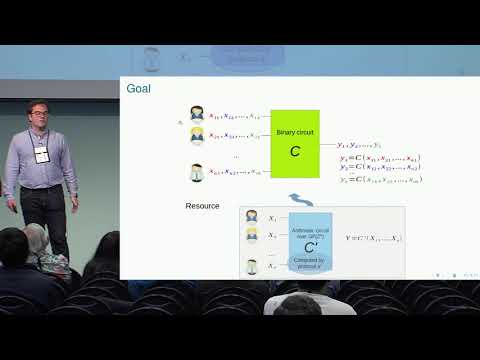Welcome to the resource topic for 2018/429
Title:
Amortized Complexity of Information-Theoretically Secure MPC Revisited
Authors: Ignacio Cascudo, Ronald Cramer, Chaoping Xing, Chen Yuan
Abstract:A fundamental and widely-applied paradigm due to Franklin and Yung (STOC 1992) on Shamir-secret-sharing based general n-player MPC shows how one may trade the adversary threshold t against amortized communication complexity, by using a so-called packed version of Shamir’s scheme. For e.g.~the BGW-protocol (with active security), this trade-off means that if t + 2k -2 < n/3, then k parallel evaluations of the same arithmetic circuit on different inputs can be performed at the overall cost corresponding to a single BGW-execution. In this paper we propose a novel paradigm for amortized MPC that offers a different trade-off, namely with the size of the field of the circuit which is securely computed, instead of the adversary threshold. Thus, unlike the Franklin-Yung paradigm, this leaves the adversary threshold unchanged. Therefore, for instance, this paradigm may yield constructions enjoying the maximal adversary threshold \lfloor (n-1)/3 \rfloor in the BGW-model (secure channels, perfect security, active adversary, synchronous communication). Our idea is to compile an MPC for a circuit over an extension field to a parallel MPC of the same circuit but with inputs defined over its base field and with the same adversary threshold. Key technical handles are our notion of reverse multiplication-friendly embeddings (RMFE) and our proof, by algebraic-geometric means, that these are constant-rate, as well as efficient auxiliary protocols for creating ``subspace-randomness’’ with good amortized complexity. In the BGW-model, we show that the latter can be constructed by combining our tensored-up linear secret sharing with protocols based on hyper-invertible matrices á la Beerliova-Hirt (or variations thereof). Along the way, we suggest alternatives for hyper-invertible matrices with the same functionality but which can be defined over a large enough constant size field, which we believe is of independent interest. As a demonstration of the merits of the novel paradigm, we show that, in the BGW-model and with an optimal adversary threshold \lfloor (n-1)/3 \rfloor, it is possible to securely compute a binary circuit with amortized complexity O(n) of bits per gate per instance. Known results would give n \log n bits instead. By combining our result with the Franklin-Yung paradigm, and assuming a sub-optimal adversary (i.e., an arbitrarily small \epsilon>0 fraction below 1/3), this is improved to O(1) bits instead of O(n).
ePrint: https://eprint.iacr.org/2018/429
Talk: https://www.youtube.com/watch?v=bPI4jCNPP4o
See all topics related to this paper.
Feel free to post resources that are related to this paper below.
Example resources include: implementations, explanation materials, talks, slides, links to previous discussions on other websites.
For more information, see the rules for Resource Topics .
